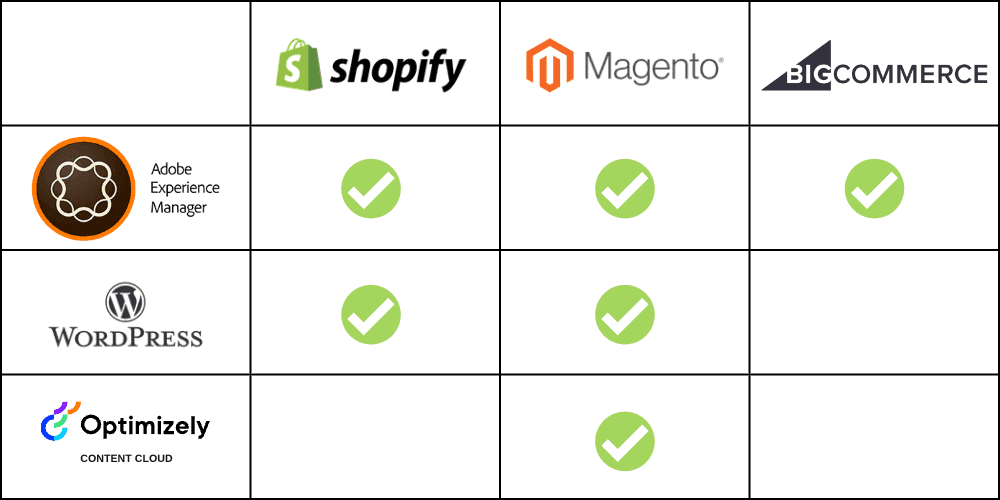
By Michał W. , February 02, 2023 · 4 min read
Solutions Bingo
What are the options to bring content and commerce together?
Based on our experience with unique project requirements, there are endless possibilities to combine software. The key is to get the best results in a given budget by evaluating the strength of a potential software component in a customer context.
This article doesn’t provide insight on technical implementation details like PWA, headless or hybrid frontends that may be required to complete the project. From a business perspective it's secondary to solutions and feature composition.
Content is king
With the rise of DTC and the focus on customer experience as opposed to mass multi-marketplace sales, content is the fuel that keeps customers engaged and conversion rates rising.
The origins of popular commerce platforms and the way they evolved leaves a lot to be desired with respect toease of building amazing content for authors and users to consume. With the rise of experimentation as a way to quickly adopt software, it makes the gap even wider.
The way to address that from experience is to bring the best content solutions with ecommerce engines.
The key features that can be added that way are:
- ease of content composition with real-time preview
- complex authoring and publishing workflows
- omnichannel content distribution
- content target with segmentation based on locale, purchase history, etc.
The following solutions provide a unique composition and set of features.
Adobe Experience Manager (AEM)
An enterprise-level CMS that works great for organizations that are complex and spread geographically. The most expensive solution on the market, it scales well and it provides ways to organize content with its excellent component architecture.
Wordpress
The most popular web software. It powers 40% of the internet. Easiest to learn with lots of people possessing the skills to get the best out of it.
Optimizely Content Cloud
A trending solution that plays nicely with A/B testing. Audience targeting is available from the same vendor. It feels like Adobe offerings made for the masses, with the ease of use that Wordpress provides.
Commerce is queen
Based on the assumption that content-related features are not used and integration capability is the key, the following commerce engines have proven to be an excellent match for content engines.
Shopify
Time to market and the ability to scale indefinitely are the main selling points. A few weeks to get ready for thousands of orders per hour is no problem with Shopify.
My favorite part is the hosted checkout. The customer's cart can be populated within the content engine space and then one API call provides the checkout url for the content cart. This greatly reduces the cost of implementing custom checkout or any kind of headless approach.
The downside is how Shopify is built for multi-market websites and their policy on payment gateways as well as the cost associated with using independent solutions in that field.
Magento
With a great API and a variety of headless frontend solutions, it's a great foundation for complex ecommerce websites integrated with any content engine. As a leading ecommerce platform it has a lot of resources and ready-to-use software to hook into content engines.
The ability to scale, especially at the API level, is the biggest reason to use Magento.
BigCommerce
It’s similar to Shopify with a more flexible approach from the vendor to integrations. Shopify can be quite limiting in what is possible with certain APIs or the API rates limitations can be intimidating for some custom features. Cost-wise BigCommerce can be a viable alternative to other SaaS offerings as well, especially as the volume of orders grows.
If a project lends itself to use many out-of-the-box features or platform extensions, BigCommerce has a limited base to choose from compared to its alternatives.
Entering the Matrix
Here's an overview of the engine compositions that Hatimeria has participated in implementing, combined in the following table:

*based on actual projects that we are working on
What struck me the most while working on those projects and talking to other more monolith-oriented developers and agencies is how exaggerated the risks associated with composition of software solutions are.
With a proper discovery phase that focuses on business needs and the strength of matching solutions, the potential wins and the prospect of gaining a competitive advantage over competing websites with a composition approach can provide tremendous value.
Would you like to innovate your ecommerce project with Hatimeria?

Addicted to Twitter, discoverer of new technology trends and most cutting-edge ecommerce solutions. Mountain man. His dream gift is a Tesla but will not disdain a Maserati.
Read more Michał's articles



